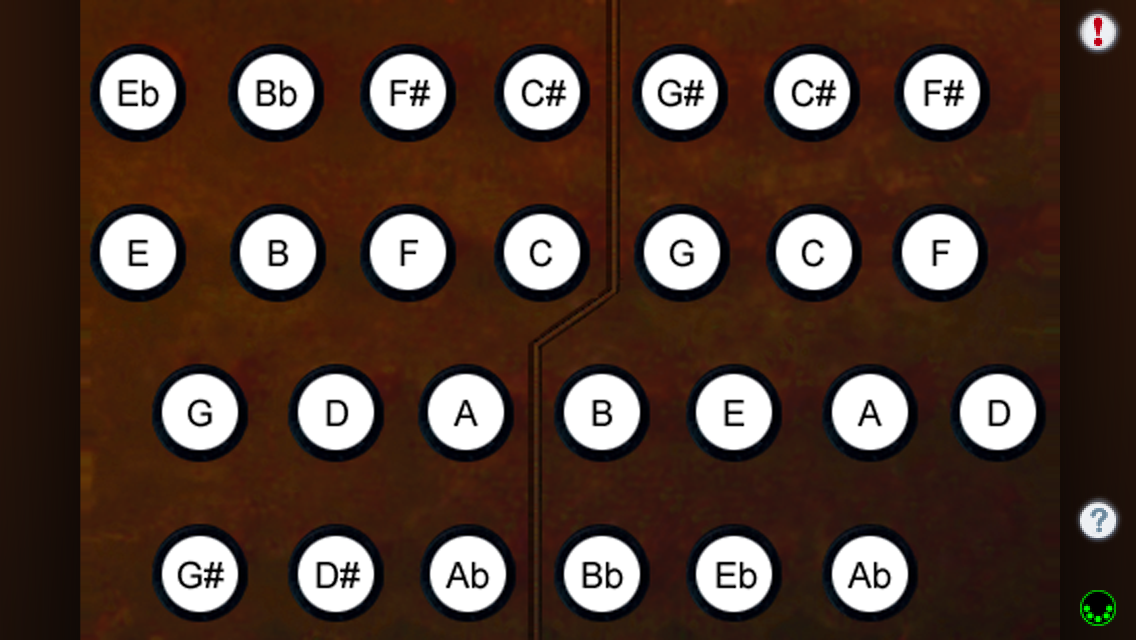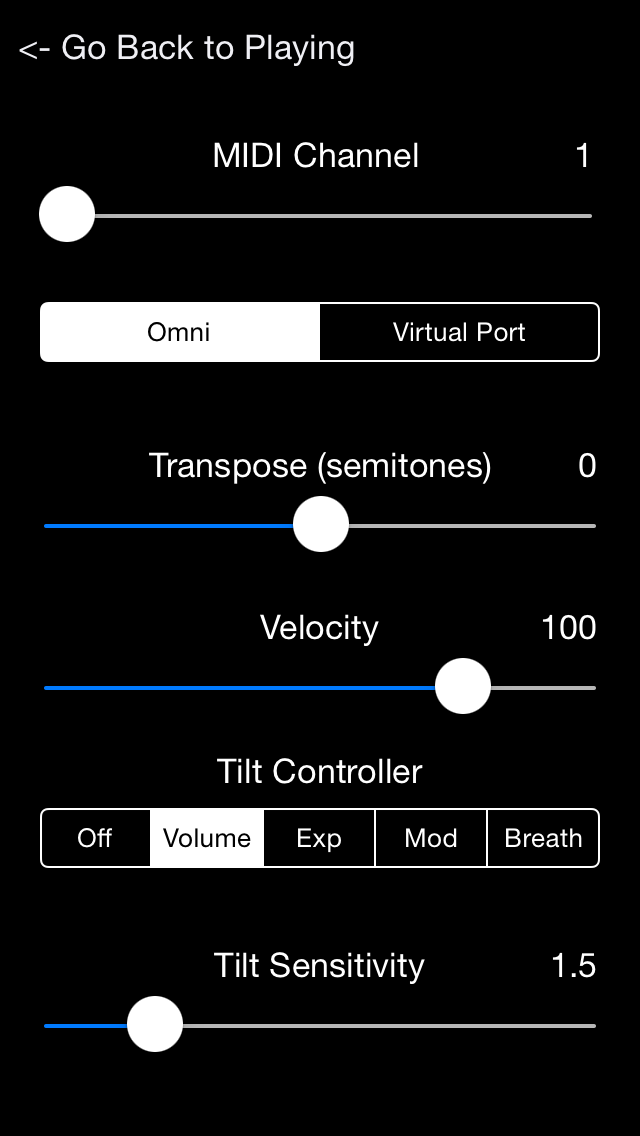MIDItina
English Concertina MIDI Control Surface
for the iPhone/iPod Touch/iPad

MIDItina is an English Concertina MIDI control surface for the iPhone/iPod Touch.
MIDItina doesn't produce any sound on its own, it is for playing hardware or software VST-style MIDI synthesizers via MIDI hardware interfaces connected to the iPad dock connector or virtual MIDI instruments like IK Multimedia SampleTank® for iOS or ThumbJam running on your iPhone.
The entire range may be transposed up or down up to one octave in semitone increments using the "Transpose (semitones)" slider on the settings page.
While playing, you may also optionally send real-time volume, expression, modulation, or wind controller MIDI messages by tilting the iPhone/iPod to the right or left.
ThumbJam by Sonosaurus is now including my highest quality Concertina
samples as a free in-app downloadable patch!
Please click the graphic to visit ThumbJam on the iTunes App Store
Here's a video demonstrating the new patch being played using MIDIAngloXL and MIDItinaXL for iPad
Same patch works and sounds the same on MIDItina for iPhone
Demonstration Video
Button layout compared to a real English Concertina
Note Guide (touch the '?' icon) shows the notes for each button

MIDItina Settings
(Touch the MIDI connector icon on the lower right of the main screen)

Set the transmit channel using the MIDI Channel slider. Any channel from 1-16 may be selected. Channel 1 is the default. Multiple devices can simultaneously talk to the MIDI synth, just make sure each device is on its own MIDI channel.
Choose between "Omni" sending MIDI data to all CoreMIDI apps or "Virtual Port" sending to a named CoreMIDI virtual output port. When the "Virtual Port option is selected, MIDItina will show up as an input option labeled "MIDItina" in apps that support virtual ports like Sonosaurus ThumbJam and MIDIBridge. "Omni" mode is selected by default.
If you want to transpose the pitches being sent out, you may set a transpose value up to +/- one octave in semitone increments on the Transpose (semitones) slider. No transpose is the default.
Note-on events are sent with a fixed velocity. Set the velocity using the Velocity slider. Any value from 0-127 may be selected. Default value is 100.
MIDItina can send Volume, Expression, Modulation, or Breath Control message by tilting the device to the right or left.
Select a controller on the Tilt Controller selector. Default is no controller messages.
When a controller is enabled, tilting the device to the right or left will send the selected controller messages to the external device. Values increase as the device is tilted farther to the right.
You may set the tilt sensitivity using the Tilt Sensitivity slider. The range is from 1 to 4, with higher values being more sensitive. Default value is 1.5.
If you ever have "stuck" notes, you may touch the "!" icon on the main screen to send a MIDI "All Notes Off" message and stop the sounds.
All settings are saved when exiting MIDItina and restored the next time it is run.
You can slide between notes, this can be very useful for all kinds of percussion and other effects.
There are several notes on the English Concertina button map that are duplicates: the first and second octave G#/Ab as well as the second octave D#/Eb. These are great to use for percussion sounds where you want to be able to stike the same note quickly. Use the transpose feature and the settings on your synthesizer to map these notes to the sounds you require.
Q: I have an iPad and the sound stops when I put four fingers on the screen.
A: Since you may want to play chords with more than 3 or 4 fingers, you'll need to turn off "Multitasking Gestures" in your iPad's Settings, under General/Multitasking Gestures.
Q: I'm running a CoreMIDI-compliant virtual synth app on my device, but I don't hear any sound when using your MIDI control surfaces.
A: Please check that "Background Audio" is enabled on the virtual synth app you are running.
Also check that the virtual synth app has an active patch on the same MIDI channel(s) you are sending from the control surface app.
Here's the settings changes you need to make for SampleTank, enable "Background Audio"

Here's a simple single instrument SampleTank patch for a flute sound
(full version of SampleTank plus Woodwind expansion pack), on MIDI channel 1

Here's the settings changes you need to make for ThumbJam:
In the Prefs/Options panel, enable "Background Audio"
Starting with ThumbJam version 2.2, CoreMIDI is enabled by default

This video shows how to change the MIDI and audio settings in SampleTank and ThumbJam
(iPad version, iPhone is similar)
Reflects version 2.1 of ThumbJam, please follow instructions above for changes for version 2.2
Battery Saving Tips
Synthesizer apps running in the background often continue to consume power even after you are done playing.
Be sure to "Force Quit" the synthesizer app when you are done playing to ensure that you don't run down your battery.
Follow these steps to force an app to close:
ThumbJam Tips
On my iPad, I create user patches from the built-in patches that have the realtime tilt controls all disabled.
In ThumbJam into the Edit/Controls for the patch, set the Volume selector to "Fixed" and the Pan, Vibrato, Tremolo, and Pitch Bend to "None"
Then save the setup as a new user patch.

If the sound level is too low through the speaker on your device, go into the Sound/(Volume/iPod) page and turn the "App Vol Boost" up to where the sound is louder but doesn't distort.

Q: Which other MIDI synthesizer apps can be played using your control surface apps?
A: The iOS Musician website is maintaining a comprehensive list of apps that support virtual MIDI ports.
The majority of my testing has been with IK Multimedia SampleTank®.
Q: What are the MIDI note number ranges?
A: The English Concertina layout note numbers range from 62 to 85, the chromatic and number layouts from 60 to 86. These values may be tranposed up or down one octave in one semitone increments using the Transpose (semitones) slider on the settings page.
Q: What are the available MIDI realtime CC controller numbers?
A: Volume (7), Expression (11), Modulation (1), and Breath Controller (2). Only one realtime controller may be enabled at a time.
Q: Where can I learn more about how to play the English Concertina?
A: Please visit the following sites for more information and online learning materials:
Q: Now that I've learned the English Concertina fingerings for some tunes on the iPhone/iPod Touch app, I'd like to buy a real instrument. Who do you recommend?
A: The Button Box carries a wide range of new and vintage instruments.
I am very interested in any suggestions for features or improvements to MIDItina for future updates, please drop me an email anytime with your ideas!
For more information, please contact Michael Eskin or visit the AppCordions.com website:

registered in the U.S. and other countries. App Store is a service mark of Apple Inc.. SampleTank® for iOS is a registered trademark of IK Multimedia ThumbJam® is a trademark of Sonosaurus LLC
